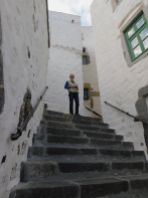Early on Sunday morning Nicholas set off for another run, this time in the fields along the north side of the island that we had driven past the previous day. The pictures above tell their own story.
After breakfast at the hotel we set off to visit the Church of the Apocalypse, the place where St John wrote his Divine Revelations around 95 AD. He lived in a cave which was turned into a church around 1000 years later and a monastery sprang up around it. We weren’t allowed to take photographs inside unfortunately. The church was quite small and about a third of the space was actually the rock formation of the ‘cave’. It must be merry hell in summer with the coach parties as I doubt there is space for more than 20 people at any given time, assuming that they are all standing up and facing the same way. Considering all the talk about climate change and the end of the world etcetera, I am surprised that the place isn’t heaving all year round but perhaps people have forgotten that everything to do with the concept of the Apocalypse started in a small cave on a remote Greek island nearly 2 000 years ago.
This time we were accompanied by the janitor who was busy vacuuming, polishing and mopping which rather detracted from the spirituality of the place. Not so much the odour of sanctity as the floral abundance of Fabuloso. He asked us where we were from. We told him we were from Symi and commented on the different way in which windows and shutters are handled between the two islands – on Symi shutters are outside and windows open inwards so the shutters have to be kept closed in the rain as otherwise they leak. (Shums notice stuff like that.) In Patmos it is the other way round. It turns out that the buildings in Patmos are so old that glass windows were added later – you only had shutters to keep out potential invaders or open spaces – which is why glass windows were added later, usually on the outside of the shutters which opened inwards, as in the photograph below. When we mentioned the limitations of the archaeologia, the state body that controls what people do to buildings in places like Symi, Patmos and Rhodes Old Town, he rolled his eyes and said, “We also have UNESCO!”
After our chat with the janitor, who was careful to lock up after us so no sneaking back inside to take unauthorised pictures, we headed back up the hill to Chora for a final walk around. Once again, we saw more companions with four legs than two. This time we were taking on a guided walk by a small, friendly but independent-minded dog (no excessive demonstrations of affection, thank you).
We are not quite finished yet. There are still some more good photos left to share with you so watch out for the next instalment.
























































































